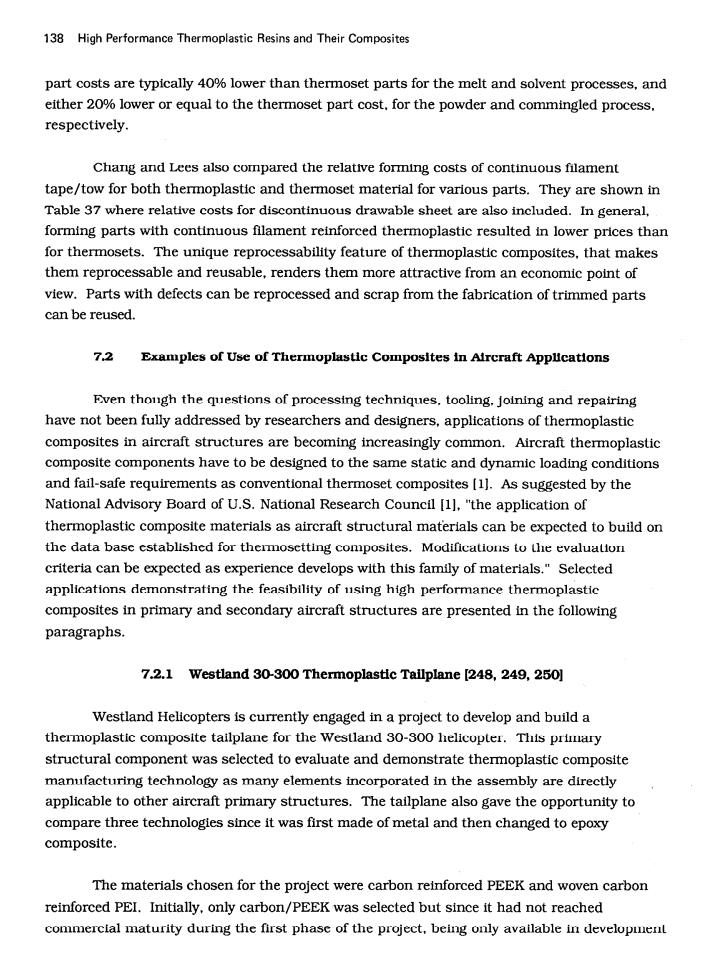正在加载图片...

138 High Performance Thermoplastic Resins and Their Composites part costs are typically 40%lower than thermoset parts for the melt and solvent processes,and either 20%lower or equal to the thermoset part cost.for the powder and commingled process. respectively. Chang and Lees also compared the relative forming costs of continuous filament tape/tow for both thermoplastic and thermoset material for various parts.They are shown in Table 37 where relative costs for discontinuous drawable sheet are also included.In general, forming parts with continuous filament reinforced thermoplastic resulted in lower prices than for thermosets.The unique reprocessability feature of thermoplastic composites.that makes them reprocessable and reusable,renders them more attractive from an economic point of view.Parts with defects can be reprocessed and scrap from the fabrication of trimmed parts can be reused. 7.2 Examples of Use of Thermoplastic Composites in Aircraft Applcations Even though the questions of processing techniques.tooling.Joining and repairing have not been fully addressed by researchers and designers,applications of thermoplastic composites in aircraft structures are becoming increasingly common.Aircraft thermoplastic composite components have to be designed to the same static and dynamic loading conditions and fail-safe requirements as conventional thermoset composites [1].As suggested by the National Advisory Board of U.S.National Research Council [1],"the application of thermoplastic composite materials as aircraft structural materials can be expected to build on the data basc cstablished for thermosetting composites.Modifications to the evalualon criteria can be expected as experience develops with this family of materials."Selected applications demonstrating the feasibility of using high performance thermoplastic composites in primary and secondary aircraft structures are presented in the following paragraphs. 7.2.1 Westland 30-300 Thermoplastic Tailplane [248,249,250] Westland Helicopters is currently engaged in a project to develop and build a thermoplastic composite tailplane for the Westland 30-300 helicopter.This priary structural component was selected to evaluate and demonstrate thermoplastic composite manufacturing technology as many elements incorporated in the assembly are directly applicable to other aircraft primary structures.The tailplane also gave the opportunity to compare three technologies since it was first made of metal and then changed to epoxy composite. The materials chosen for the project were carbon reinforced PEEK and woven carbon reinforced PEI.Initially,only carbon/PEEK was selected but since it had not reached commercial maturity during the first phasc of the project,being only available in developient138 High Performance Thermoplastic Resins and Their Composites part costs are typically 40% lower than thermoset parts for the melt and solvent processes, and either 20% lower or equal to the thermoset part cost. for the powder and commingled process, respectively. Chang and Lees also compared the relative forming costs of continuous filament tape/tow for both thermoplastic and thermoset material for various parts. They are shown in Table 37 where relative costs for discontinuous drawable sheet are also included. In general, forming parts with continuous filament reinforced thermoplastic resulted in lower prices than for thermosets. The unique reprocessability feature of thermoplastic composites, that makes them reprocessable and reusable, renders them more attractive from an economic point of view. Parts with defects can be reprocessed and scrap from the fabrication of trimmed parts can be reused. 7.2 Examples of Use of Thermoplastic Composites in Aircraft Applications Even though the questions of processing techniques, tooling, joining and repairing have not been fully addressed by researchers and designers, applications of thermoplastic composites in aircraft structures are becoming increasingly common. Aircraft thermoplastic composite components have to be designed to the same static and dynamic loading conditions and fail-safe requirements as conventional thermoset composites [ 11. As suggested by the National Advisory Board of U.S. National Research Council [l], “the application of thermoplastic composite materials as aircraft structural materials can be expected to build on the data base established for thermosetting composites. Modifications to the evaluation criteria can be expected as experience develops with this family of materials.” Selected applications demonstrating the feasibility of using high performance thermoplastic composites in primary and secondary aircraft structures are presented in the following paragraphs. 73.1 We&land 30-300 Thermoplastic Tailplane [248,249.2!50] Westland Helicopters is currently engaged in a project to develop and build a thermoplastic composite tailplane for the Westland 30-300 helicopter. This primary structural component was selected to evaluate and demonstrate thermoplastic composite manufacturing technology as many elements incorporated in the assembly are directly applicable to other aircraft primary structures. The tailplane also gave the opportunity to compare three technologies since it was first made of metal and then changed to epoxy composite. The materials chosen for the project were carbon reinforced PEEK and woven carbon reinforced PEI. Initially, only carbon/PEEK was selected but since it had not reached commercial maturity during the first phase of the project, being only available in development